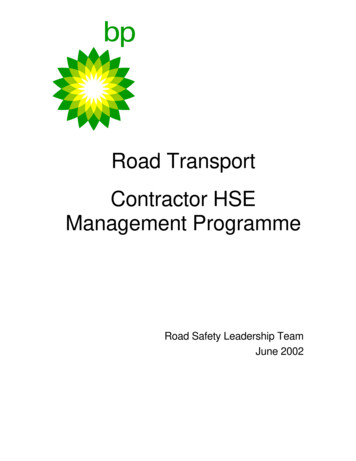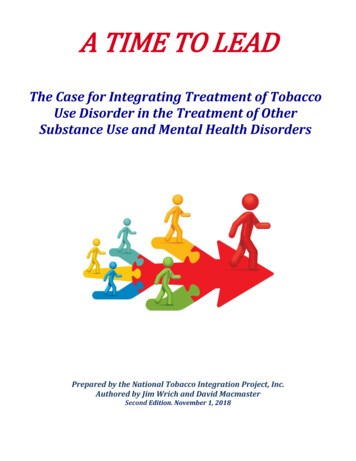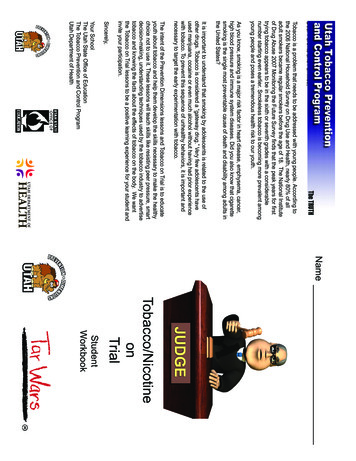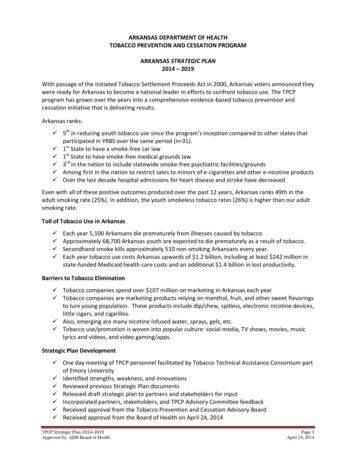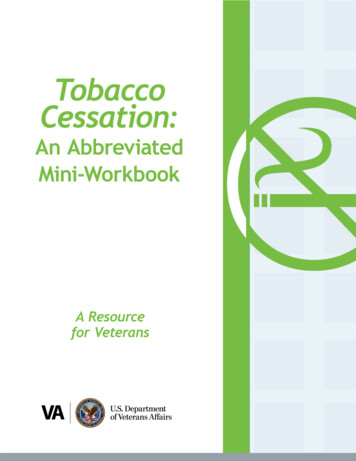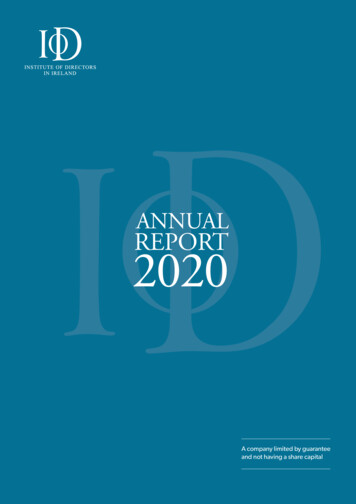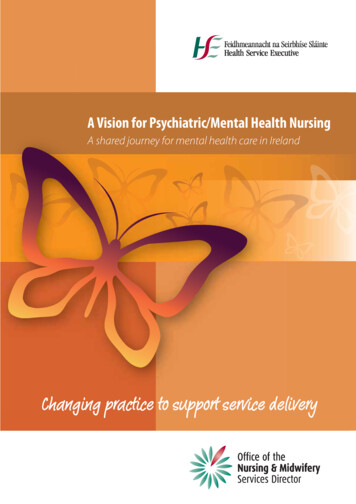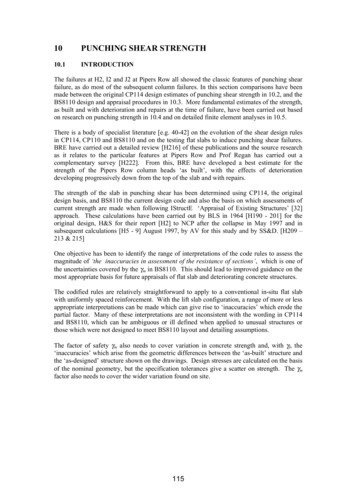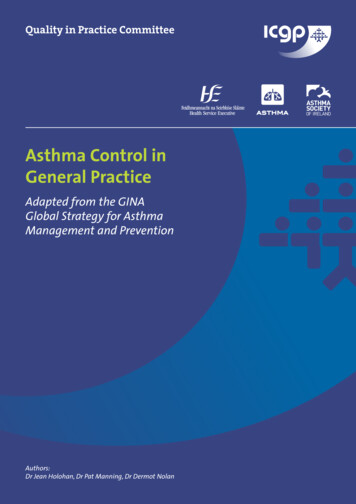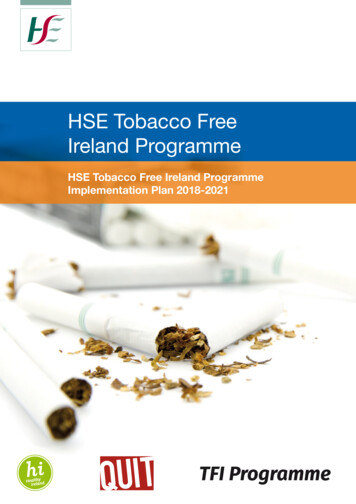
Transcription
HSE Tobacco FreeIreland ProgrammeHSE Tobacco Free Ireland ProgrammeImplementation Plan 2018-2021
HSE Tobacco Free Ireland ProgrammeTable of ContentsGlossary1Foreword2Introduction3Context for Action4Smoking in Ireland5Strategic Direction10Targets and Outcomes 2018-202111Measurable Outcomes12Actions, Measures and TFIPGTUSLAAssistant National DirectorCommunity Healthcare OrganisationChildren & Young Peoples Services CommitteesDepartment of HealthEnvironmental HealthGlobal Network of Tobacco Free Healthcare ServicesHospital GroupHealth Information & Quality AuthorityHealth Promotion and ImprovementHealthy IrelandHuman ResourcesHealth Service ExecutiveKey Performance IndicatorMental HealthMaternal and Newborn Clinical Management SystemNational Behavioural Support Management SystemNational Clinical Effectiveness CommitteeNursing and Midwifery Board of IrelandNational Service PlanStrategic Planning & TransformationTobacco Free CampusTobacco Free Campus PolicyTobacco Free IrelandTobacco Free Ireland Programme GroupThe Child and Family Agency (Tús Lá)1
HSE Tobacco Free Ireland ProgrammeForewordThe HSE is committed, under Action 4.5 of the Health Service Reform in Healthy Ireland, to “establishmulti-disciplinary national teams within Strategic Planning and Transformation to lead and takeresponsibility for policy priority areas such as Tobacco Control, Healthy Eating and Active Living (HEAL),Healthy Childhood, Alcohol, Wellbeing and Mental Health, Positive Aging and Sexual Health.” The prioritygroups will ensure appropriate governance across the organisation for these areas and ensure thatthe priorities in the Healthy Ireland Implementation Plan are delivered effectively. The establishment ofHospital Groups and Community Healthcare Organisations (CHOs) and more recently the appointmentof a Health and Wellbeing Head of Service to each of the CHO areas will facilitate the work of thePriority Programmes. This will help to ensure that Healthy Ireland (HI) priorities are delivered across theHSE through a collaborative approach which in turn will provide a more integrated service with betteroutcomes for service users.The main aim of the new Tobacco Free Ireland Programme is to take responsibility for and systematicallydrive policy priorities in the area of tobacco control across the HSE. Ms. Martina Blake has been appointedas lead to the Tobacco Free Ireland Programme.2
HSE Tobacco Free Ireland ProgrammeIntroductionThe Tobacco Free Ireland Policy PriorityProgramme was established in late 2016 aspart of the Healthy Ireland in the Health ServicesImplementation Plan.1 It has a remit to:“mobilise the health services toimprove health and wellbeing andplay its part in the achievementof a reduction in smokingprevalence to less than 5%of the population by 2025”.The Programme (Appendix A) works to coordinateand lead tobacco control activity across the healthservices to ensure implementation of the HSEactions contained within the Government TobaccoFree Ireland2 strategy.1Healthy Ireland in the Health Services NationalImplementation Plan 2015-2017, Health Service Executive,2015.2Tobacco Free Ireland: Report of the Tobacco PolicyReview Group, Department of Health, 2013.This national implementation plan (2018-2021)sets out the HSE strategic direction and priorityactions to achieve this.The objectives of the Tobacco Free Ireland PolicyProgramme over the next four years are to:â Prioritise the protection of children in all of ourinitiatives and contribute to the denormalisationof tobacco use for the next generationâ Support people to quit and treat tobaccodependence as a health care issueâ Monitor, build and maintain compliance withtobacco legislation3
HSE Tobacco Free Ireland ProgrammeContext for ActionTobacco use is the leading cause of preventabledeath in Ireland with 5,800 smokers dying eachyear from tobacco related diseases. Smokingrelated deaths are mainly due to cancers, chronicobstructive pulmonary diseases (COPD) andheart disease. Cigarettes contain over 7000 toxicchemicals, many of which are proven to causecancer. Smoking harms almost every organ ofthe body, causing many different illnesses anddiseases. A long-term smoker has an average lifeexpectancy of approximately, 10 years less thana non-smoker. The younger you are when youstart smoking, the more likely you are to smokefor longer and to die early from smoking.The Healthy Ireland Survey taken in 20173 reporteda smoking prevalence of 22%, 18% daily smokersand a further 4% occasional smokers. While wehave seen a reduction in youth initiation from12.3% in 2010 to 8.3% in 2014 among the 1017 age group, there is a high level of smokingamong young adults with one in every three25-34 year olds currently smoking.43Healthy Ireland Survey 2017: Summary of Findings,IPSOS MRBI, 2017.4An Assessment of the Economic Cost of Smoking inIreland, ICF International, 2016.Tobacco related morbidity and mortality accountsfor over 200,000 hospital episodes annually withthe total cost to the health service estimated tobe over 460 million. The total estimated cost oflost productivity is over 1 billion. This comprisesproductivity lost through smoking breaks, smokerstaking additional absence from work and thepremature death of employed workers. The largestproportion of the lost productivity from smokingis estimated to be from the premature death ofemployed individuals.4There is an ever increasing recognition amongpolicy makers and health service managers/service providers that we need to reorient ourhealth services towards prevention of tobaccorelated chronic disease as these are the majordrivers of healthcare costs.
HSE Tobacco Free Ireland ProgrammeSmoking in Ireland StatisticsSmoking Prevalence(Ref: Healthy Ireland Survey 2017)22%25%18% daily4% occasionallyVS27%20%Ex-smokersIreland now has morequitters than smokersPrevalence by Age(Ref: Healthy Ireland Survey 2017)Age Category 65-759%75 * Worth noting that one in three 25-34 year olds.Daily Exposure to Second Hand Smoke(Ref: Healthy Ireland Survey 2017)34%Smokers10%Non-Smokers16%Population are exposed to secondhand smoke on a daily basis5
HSE Tobacco Free Ireland ProgrammeAttitudes to Quitting(Ref: Healthy Ireland Survey 2017)(Ref: Youth Smoking in Ireland, 2018)Tryingto quitAttitudeâ 57% of current smokers arethinking about quittingâ Smoking rates are higher in moredeprived areas than more affluentones. 32% of those living in themost deprived areas are currentsmokers, compared to 16% ofthose living in most affluent areas42%Not thinkingabout quitting13%57%Thinking about quittingThinking aboutquitting but notplanning toActivelyplanningto quit16%28%â Current smokers were over 70%more likely to report distressindicative of probable mentalhealth problems, compared tonon-smokers, independent ofage, gender and social classâ 47% of all who have smoked inthe past 12 months have madea quit attemptInteractions with Healthcare Professionals(Ref: Healthy Ireland Survey 2017)Discussed Smoking with a HealthcareProfessional in the last yearPharmacist10%Nurse22%GP35%Hospital Doctor25%6Dentist20%12%Other HealthcareProfessional
HSE Tobacco Free Ireland ProgrammeRoll Your Own (RYO) Cigarettes(Ref: Roll Your Own Report, 2017)â Proportion of smokers using3.5%24.6%2003RYO cigarettes has increasedfrom 3.5% in 2003 to 24.6% in2014.â Those under 25 years of ageare three times more likelyto smoke RYO cigarettescompared to those agedover 25.2014Age Group44.9%23.9%22.5%24%17.1%8.2%Under 2525-3435-4445-5455-6465 E-cigarette Usage(Ref: Healthy Ireland Survey 2017)7%gAmonkersoSm40%PreviouslyUsed 1%7%Use CurrentlyUse CurrentlyngAmo okersmEx-S9%PreviouslyUsedUse CurrentlygAmonrNeve ersSmok1%PreviouslyUsed7
HSE Tobacco Free Ireland ProgrammeDisease Burden(Ref: Nash et al. Literature Review)Causeof ratoryDiseasesDigestiveDiseasesFinancial Burden of Tobacco Use in Ireland(Ref: ICF Economic Assessment, 2016) 460m HealthService 1.6bn Exchequer 9bnLoss of Welfare fromMorbidity & MortalityCost to Health Services 171m 13mHospitalInpatientAdmissions 15mHospitalDay CaseAppointmentsHospitalOutpatientAppointments 10mHospitalEmergencyDepartmentAttendances 256mPrimary CareTobacco Free Ireland Strategy(Ref: Tobacco Free Ireland 2013)1Provide leadership – policy,practice and clinical2Protect children throughdenormalisation of tobaccouse and promotion of tobaccofree environments8Five Key Areasfor Action3Regulate the retailenvironment and monitorlegislative compliance5Monitor tobaccouse and prevalenceand evaluate the4effectiveness ofTreat tobacco interventionsdependence as acare issue
HSE Tobacco Free Ireland ProgrammeDeterminants of SmokingA range of socio-demographic, environmental, behavioural and personal indicators predict the likelihoodof adopting or rejecting smoking, particularly in early adolescence (90% of initiation to adult smokingcommences in adolesence). A decision to smoke leads to trialling the behaviour, and the resultingexperience is mediated by each of the three major streams of influence – the personal, the social settingand broader expectations and attitudes.ENVIRONMENTâ Images of smokingin popular mediaâ Tobacco industryâ Accessâ PriceCommunity normstobacco marketingTobacco environmentâ Exposure toâ Adult smoking prevalenceâ Restrictions on smokingâ Attitudes to youth andyouth cultureâ Socio-economic andEXTRINSIC FACTORScultural contextINTRINSIC FACTORSFamilyinfluencesPersonal beliefsand valuesFirst tryâ Parental smokingâ No risk in tryingâ Sibling smokingâ It won’t happen to meâ Parental values andattitudes resmokingExperimentationâ Individual choiceâ Adulthood aspirationsâ Socio-economicstatusâ Curiosity‘Social’smokerRegularsmokerâ Perceptions ofsmoking normsâ Risk-taking propensityâ esâ Peer affiliations andfriendshipsPersonalphysiological factorsResumptionof smokingâ Connectedness toâ In utero exposureâ Puberty andschool and/or homeâ Sense of alienationâ GeneticsadolescenceAdultnon-smokerAdultsmoker9
HSE Tobacco Free Ireland ProgrammeStrategic DirectionImproving the health and wellbeing of Ireland’spopulation is a national priority and a key elementof healthcare reform. As part of this reform andin response to an unsustainable level of chronicdisease among our population, the HealthyIreland (HI) Framework was adopted by the IrishGovernment in October 2013. The Healthy IrelandFramework draws on existing policies but proposesnew arrangements to ensure effective cooperation, collaboration, to implement evidencebased policies at government, sectoral, communityand local levels. It is about each individualsector helping to improve health and wellbeing,multiplying all efforts and delivering better results.It proposes a necessary shift towards a broader,more inclusive approach to governance forhealth, moving beyond the health service, acrossnational and local authorities, involving all sectorsof society, and the people themselves. HealthyIreland describes supportive mechanisms toensure effective co-operation between the healthsector and other areas of Government and publicservices concerned with social protection, children,industry, food safety, education, transport, housing,agriculture and the environment.The Health Service commitment to the delivery ofHealthy Ireland is reflected in its Healthy IrelandImplementation Plans across the CHOs andHospital Groups. The Strategic Planning andTransformation Office is responsible for driving thisagenda across the entire health service. There isan ongoing shift in focus towards a prevention10agenda, where all services have a requirement tosupport people to stay healthy and well, reducehealth inequalities and protect people from threatsto their health & wellbeing. The vision is to supportevery individual and sector of society to play theirpart in achieving a healthy Ireland through;1. Reducing Chronic Disease – the biggest riskto our population’s health and our services2. System Reform – ensuring that we deliverthe significant reforms which are underwayto support a better health system3. Staff Health and Wellbeing – ensuring wehave a resilient and healthy workforceTobacco Free IrelandNational PolicyThe Department of Health published the TobaccoFree Ireland Policy in 2013 and is the successor tothe previous National Policy Towards a Tobacco FreeSociety. The policy sets out the plan for the future inachieving the goal of reducing smoking prevalence toless than 5% by 2025. The policy document makessixty three recommendations for cross governmentaland non-governmental organisations, including anumber of recommendations for the health sector.It is about each individual sector helping to improvehealth and wellbeing, multiplying both our efforts andour results.
HSE Tobacco Free Ireland ProgrammeTargets and Outcomes for the HSE TobaccoFree Ireland Programme 2018-2021It is recognised that achieving the populationlevel outcomes and targets will be the result ofthe cumulative impact of the sixty three specifiedactions in Tobacco Free Ireland. In this context, theProgramme will work with a broad range of externalstakeholders seeking to minimise the burden oftobacco related morbidity and mortality in Ireland.Engagement and cooperation across departmentsand sectors to support implementation of allactions in the Tobacco Free Ireland Policy andAction Plans are led by the Department of Health.The focus for this implementation plan is on theactions that can be delivered by, or whose deliverycan be mediated by the health services.The HSE’s contribution to the 2025 goal of lessthan 5% smoking prevalence will be progressedthrough the following key areas:â Prioritise the protection of children in all of ourinitiativesâ Denormalise tobacco use for the next generationâ Treat tobacco dependence as a health care issueâ Encourage, promote and support smokers toquit through our sustained QUIT campaign,development of our cessation services andthrough comprehensive training for our staffâ Continue to implement and maintain ourTobacco Free Campus policies and promoteTobacco Free EnvironmentsThis HSE Tobacco Free Ireland strategicImplementation Plan acknowledges that it has arole to play in the delivery of a Tobacco Free Ireland( 5% smoking prevalence) but it is not the onlysector which has a responsibility in this objective.The cross governmental Tobacco Free Irelandpolicy on which this HSE plan is based outlines awhole series of actions for a range of departmentsand stakeholders, taking a multifaceted approachin achieving prevalence reduction. Legislativeand taxation measures for example have asignificant role to play, however the evidence is notsophisticated enough to establish the contributionof each measure in the reduction of overallprevalence, therefore this strategy specifically doesnot set targets for an incremental reduction insmoking prevalence. It is envisaged however thatthe range of actions outlined within this strategy willcontribute to an incremental reduction in smokingprevalence in support of the Department ofHealth’s Goal for a Tobacco Free Ireland by 2025.The HSE has established a Tobacco Free IrelandPriority Programme and convened a crossdivisional implementation group. The publicationof this four year strategic document outlinesthe actions which the HSE has committed to inorder to play its part in the achievement of the5% prevalence goal. This Tobacco Free IrelandProgramme Implementation Plan (2018-2021) willbe the first of two action plans developed underthe HSE Tobacco Free Ireland Programme.â Protect service users, staff and the public fromthe effects of second hand smokeâ Monitor, build and maintain compliance withtobacco legislationâ Work with our internal stakeholders to monitorthe evidence in terms of tobacco control andparticipate in an active research and surveyprogramme.â Monitor and evaluate the effectiveness of allHSE interventions11
HSE Tobacco Free Ireland ProgrammeMeasureable outcomesThe principle source of information is the Healthy Ireland Survey, which through repeated cross sectional survey of a representative sampleof the population provides for tracking of smoking prevalence, quitting intentionality and quitting behaviour. It provides insights acrosskey population groups, but is not useful for tracking at CHO or HG level. However, in relation to other areas and population groups, itshould be noted that there are limitations to the existing routine information systems that are currently used to report on key aspectsof the HSE Tobacco Free Ireland Programme Plan. Regarding smoking in pregnancy, there is currently no routine information system.The Growing Up In Ireland survey has some utility. A new maternity information system combined with a new behavioural managementsystem will help. Likewise, smoking among people with mental health problems is not trackable through routine information.A comprehensive research programme and secondary analysis is useful in that regard and forms part of this programme plan.OutcomeA sustained downward trend in the levels of tobacco use in the general population in children and young people, in pregnancyand those with Mental ill health.TargetOverall Target 5% smoking prevalenace by 2025 as indicated in cross governmental TFI strategy. The HSE does not takeresponsibility for reaching the 5% target. It is envisaged however that the range of actions outlined within this strategy willcontribute to an incremental reduction in smoking prevalence in support of the DOH goal for a Tobacco Free Ireland by 2025.InputsOutput MeasuresQUIT campaign aimed atoverall population awarenessand understanding of risksof tobacco and benefits ofquitting.Targeted, dynamic multi-media Decrease in prevalence ofplan:tobacco use.Monitoring, evaluation andtailoring of messaging, mediaand timing as required acrosssearch, social, digital andtraditional media (includingpublic relations)Increased website visits duringactive media bursts. Cleartracking of activity.Omnibus and specific researchon target audiences whererequired.Increase prevalence of positivequit intentions.Increase prevalence of quitattempts particularly amongmen aged 25-44.Ongoing measurement andunderstanding of QUIT signups online.No. of clients who contactQUIT Freephone.Visits to website.Redevelopment of QUITwebsite12Outcome MeasuresBaseline (2017)22%October/November 2017media burst resulted in 89%increase in sessions on QUIT.ie57% of smokers are at leastthinking about quitting42% of current smokers havemade a quit attempt in thepast 12 months16,820 during 20172,914 during 2017245,430 during 2017Redevelopment of QUITwebsite in line with HSE digitalroadmap and to maximiseQUIT sign upsOngoing measurementand understanding of userexperience on QUIT.ieClosed Facebook groupscreated, piloted, moderatedand evaluatedSignups to closed Facebookgroup and completion ofclosed Facebook programmeIntroduction of user feedbackon QUIT.ieNo. of referrals to intensiveNo existing datacessation support by healthprofessionals annuallyNo. of self-referrals to intensive No existing datacessation supportNo. of clients receiving11,952intensive cessation supportthrough HSE servicesTo be piloted
HSE Tobacco Free Ireland ProgrammeInputsOutput MeasuresOutcome MeasuresBrief intervention forsmoking cessation throughimplementation of MakingEvery Contact Count trainingNo. staff trained in MECConline modules.No. staff trained in skills topractice moduleNo. non-HSE staff trainedNo. undergrad healthprofessional trainees trainedNo. of clients from specificpopulation groups receivingintensive cessation supportthrough HSE services (Pregnant,those with mental ill health, men,youth and low SES)Increase proportion of clientswho discussed a quit attemptwith a healthcare professional to 40% for GPs to 35% for hospital doctors to 25% for nurses to 20% for other healthprofessionalDevelopment of clinicalguidelines for the identification,diagnosis and treatment oftobacco dependenceClinical guidelines developed,stakeholder consultationcomplete, guidelines endorsedby Minister for Health andpublishedIncrease in no. smokers withinthe last 12 months who havestopped smoking for one dayor longer because they weretrying to quitBaseline (2017)No existing data35%25%22%12%47% of all who have smokedin the past 12 months havemade an attempt to quitReduction in no. people who18% daily smokerssmoked tobacco products4% occasional smokersdaily and occasionally by0.5% prevalence per year(interdependent on DoH measures)On-going implementation andmonitoring of HSE TobaccoFree Campus Policy in HSEservicesImplementation and on-goingmonitoring of HSE TobaccoFree Campus Policy in 100%HSE servicesTFC Policy implemented in100% Mental Health ApprovedCentres100% Mental HealthResidential Centres100% Older Persons Services100% Disabilities Services100% Primary Care settingsOn-going monitoring andenforcement of tobaccolegislationNo. test purchases carried out% increase in compliance with 429 (90% compliance)sale of tobacco products tovolunteer minors% increase in compliance with15,064 (80% compliance)smoke free workplace legislationNo. of tobacco inspections (alltypes - inspection excluding testpurchase of which details above)· TPD inspections and relatedsamples· Advisory· Complaint· Follow up· Planned· Surveillance· SurveyYouth Initiation and Prevalence63% Mental Health ApprovedCentres38% Mental Health ResidentialCentres63% Older Persons Services49% Disabilities Services100% Primary Care SettingsReduction in no. children whohave tried smoking16%Reduction in no. children whohave tried smoking monthly ormore frequently8.3%13
HSE Tobacco Free Ireland ProgrammeActions, Measures and DeliverablesTheme 1:Provide Leadership for the implementation of the HSE elements of Tobacco Free Ireland1.1TFI PolicyActionAction IdentifiedProposal for “HOW” this will be met1Support effective implementation of theNational Healthy Ireland and Tobacco FreeIreland Action Plan (DoH) and ensure theTobacco Free Ireland Programme prioritiesare included in the National Service Planand relevant annual operational Plans.Tobacco Free Ireland Priority Programme NationalImplementation Group will identify & agree prioritiesfor National Service Plan/Operational plans andsupport delivery of same across the CHOs andhospital groups.Develop a suite of Key PerformanceIndicators to:Work with Strategic Planning and Transformationand the Performance and Planning Unit and servicerepresentatives to propose, review and qualityassure NSP, operational plans and KPIs. Examineexisting tobacco related KPIs and develop newKPIs to monitor performance.1.2a) Monitor impact of HSE delivered orfunded interventions, programmes andservicesb) Monitor delivery of this Implementationplan1.3Identify resource implications to deliver TFIactions contained within this plan.Engage with HI Governance group and HSE HIOffice to support inclusion of and delivery of theTFI actions across the CHOs and Hospital groups.Draft annual PIDs for operational activities and newprojects based on programme.Prepare business cases and funding estimate bidsand approve at TFIPG.1.4Engage with international health colleaguesto share learning and experiences in theimplementation of quality standards inrelation to tobacco management.Membership of the Global Network of Tobacco FreeHealthcare Services (GNTH).Participation in Global Network conferences andforums.Participation in development and hosting of WorldConference on Tobacco and Health in 2021 withthe DoH.1.51410.1Government Departments and stateagencies including the Health ServiceExecutive will continue to liaise and work withnon-governmental organisations in order toachieve policy aims set out in this plan.Ensure on-going engagement via: TACU within theDOH, state agencies and NGOs and the TobaccoControl Partners group.On-going monitoring of cross governmental strategicpublic policy consultation processes.
HSE Tobacco Free Ireland ProgrammeDeliverablesResponsibleTime FrameCommenceCompleteAnnual priority actions and key performanceindicators identified and agreed and included in theNational Service Plan and relevant divisional serviceoperational plans.TFI Programme Team and TFIPG2018Annual2021Suite of KPIs identified.TFI Programme Team, HI lead, CHO/Hospital Group representatives2018Annual2021TFI Programme Team2018Annual2021TFI Programme Team2018Annual2021TFI Programme Team2018Annual2021KPI review and monitoring sub group of TFIPGGroup established.Annually agreed KPIs in NSP and Operational Plans.TFI actions included in CHO and hospital groupHealthy Ireland plans.PIDs drafted for all new tobacco activities annually.Annual funding estimates bid drafted andbrought to Leadership/DoH through Planningand Performance.Participation in or coordination of Internationaltobacco events to support the Tobacco FreeIreland agenda.Participation in international research/events andthe GNTH to promote quality standards.Partners group established under the Tobacco FreeIreland Programme.Three annual meetings and on-going collaboration.TFI Programme submits feedback to crossgovernmental policy consultation processes toembed tobacco control actions in future planning.15
HSE Tobacco Free Ireland ProgrammeTheme 2:Protection of children in all of our initiatives, denormalise tobacco use for the next generation andpromote tobacco free environments.TFI PolicyActionAction IdentifiedProposal for “HOW” this will be met2.17.1The protection of children must beprioritised in all of the initiatives outlined inthe policy.Work with Tusla to support the development of apolicy for the protection of children from second handsmoke in foster care homes and all levels of care.2.27.5Promote tobacco free campuses for allhealthcare governmental and sportingfacilities in consultation with keystakeholders.Work with the DOH and a corporate partner todevelop a tobacco free campus toolkit for all typesof workplaces.Work with LCDCs and CYPSCs to promote tobaccofree public spaces and environments for children.2.37.2Denormalisation must be a complimentaryunderpinning theme for all of the initiativeswithin the policy.Work with the Department of Education and Scienceand partners to develop the tobacco elements of therevised SPHE junior cycle curriculum.2.47.2/7.5Engage internally with CHOs/Hospital groups and externally withrelevant stakeholders to ensure thatdenormalisation is a complementaryunderpinning theme for all initiatives.Engage with the Mental Health and SocialCare national offices to support the successfulimplementation of the HSE TFC Policy.2.4.116Engage with HIQA and MH Commission in a formalway to lobby for inclusion of TFCP as part of theiraudit criteria.
HSE Tobacco Free Ireland ompleteEngage with TUSLA to advocate that they prioritisethe development of a policy to protect childrenfrom second hand smoke in all levels of care andsupport them in this process.TFI Programme Team20192021Generic Tobacco Free online toolkit developed.TFI Programme Team/DoH20182018Guidance document developed for LCDCs topromote tobacco free environments, promotedenormalisation and signpost to local cessationsupports.TFI Programme Team2019202020182021Input provided at LCDC forums.Tobacco elements included in the SPHE juniorcycle curriculum.TFI Programme Team/SP&T EducationProgramme Manager20192020TFC targets set and agreed for each service areawithin each CHO/Hospital group.TFI Programme Team/TFIPG2018201920182021Guidance tools and resources for implementationin specific service areas developed.20182019Workshops/conference/events planned & deliveredto support quality improvement/monitoring of TFCpolicy.2018202120182020Implementation status monitored at service/operational level.HIQA/MH Commission supported to include TFCpolicy and the treatment of tobacco addiction aspart of their audit criteria.CHO RepresentativeAcute Service Representative/MentalHealth Representative/Social CareRepresentativeTFI Programme Team/QualityImprovement17
HSE Tobacco Free Ireland ProgrammeTFI PolicyActionProposal for “HOW” this will be met2.4.2Work with HR to progress tobacco free Irelandobjectives.2.4.3Develop a tobacco free campus policy communicationscampaign targeting service users the public and staff.2.4.4Work with Quality Improvement/Quality Assuranceand Verification to progress and embed TFC policyin their routine audits and their quality improvementprocesses.2.4.5Engage with National Estates Office to incorporateTFC policy provisions in the development of all newsites and buildings.2.52.62.6.118Action Identified9.5Undertake a social marketing campaign(DOH funding dependent) focusing on therisks to children from exposure to secondhand smoke with particular reference tosmoking in cars.Communications to review social marketing campaigndeveloped in relation to second hand smoke (SHS).Engage with partner agencies and youthorganisations to address tobacco controlamong youth.Work with partner agencies i.e. Spunout and ICS todevelop targeted tobacco control programmes tosupport cessation/prevent initiation.Review and publish ‘Quit 4 Youth’ training resources.
HSE Tobacco Free Ireland ProgrammeDeliverablesResponsibleHR representative nominated to TFIPG.SP&T/TFIPG/HRHR representatives to lead the revision of theNational TFC Policy.TFI Programme Team/HR/all divisionsTimeframeCommenceComplete20202021HSE tobacco free campus policy reviewed, revisedand signed off.Communicate the revised policy to all levels ofmanagement and staff.Suite of TFC communication tools developed andimplemented.Communications/TFI Programme Team/CHOs/HGs20192021TFC is included in quality improvement practice/protocols.TFI Programme Team/QualityImprovement/Quality A&V20202021TFC policy provisions routinely incorpo
the body, causing many different illnesses and diseases. A long-term smoker has an average life . the total cost to the health service estimated to be over 460 million. The total estimated cost of . 19% 34% 24% 21% 20% 16% 9% 15-24 25-34 35-44 45-54 55-64 65-75 75 5 Population are exp
